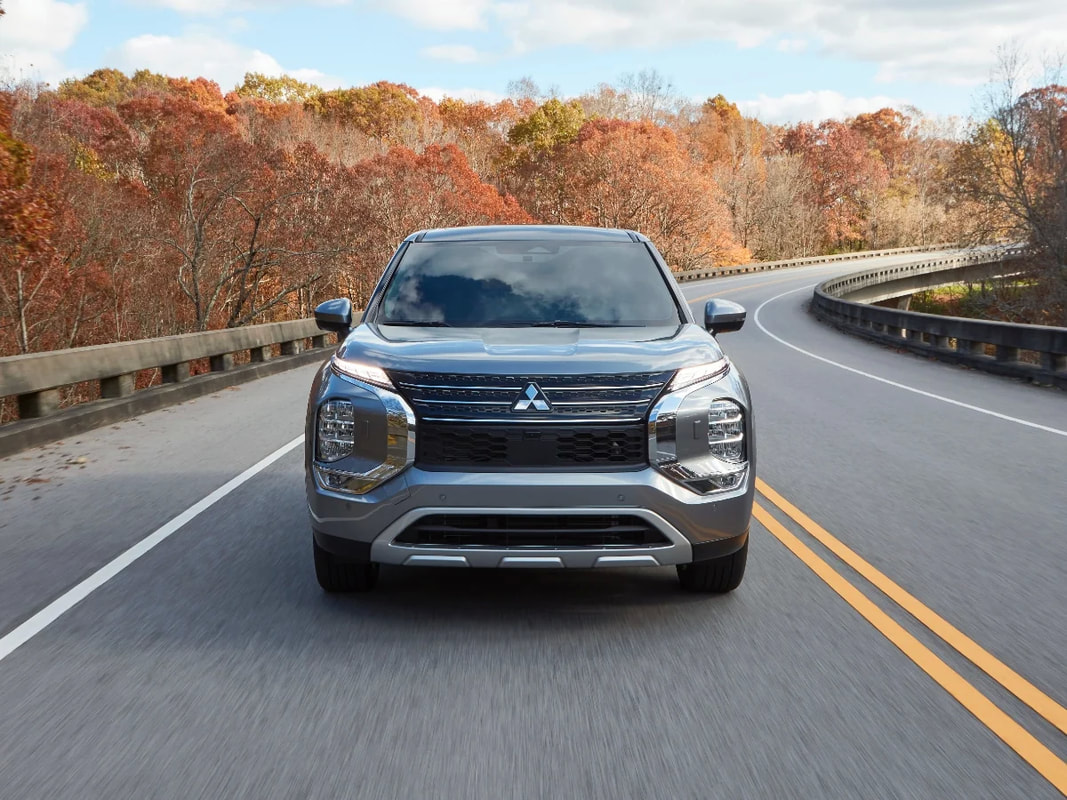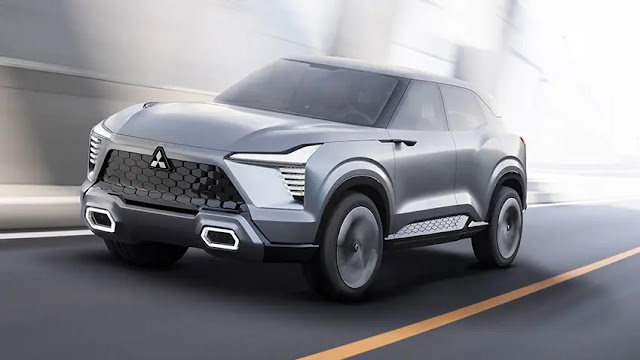Mitsubishi Mi-Pilot Assist - What Is It?
Automakers are making a steady stream of new Level 2 driving assistance technologies available to consumers. Typically, they combine adaptive cruise control with lane-centering assistance to make the overall driving experience safer, less stressful, and more confidence-inspiring.
Some work only at lower speeds and are commonly known as traffic-jam assistance. Mazda offers this kind of technology on its turbocharged versions of the Mazda3 and Mazda CX-30, and it operates at speeds up to about 40 mph.
Some work at a full range of everyday speeds and in a hands-free manner on approved highways and are considered Level 2+ semi-autonomous systems. An excellent example of this technology is General Motors Super Cruise.
Most, however, are similar to the new Mitsubishi Mi-Pilot Assist system, operating at a full range of everyday speeds but requiring Mitsubishi drivers to keep their hands on the steering wheel at all times.
What is Mi-Pilot Assist?
Mitsubishi introduced Mi-Pilot Assist on the all-new 2022 Outlander crossover SUV. The Outlander shares much of its underlying engineering and technology with the Nissan Rogue, and Mi-Pilot Assist is Mitsubishi's version of Nissan ProPilot Assist.Mi-Pilot Assist combines adaptive cruise control with stop-and-go capability and a lane-centering assistance system to provide low-speed traffic-jam assistance and higher speed Level 2 advanced driving assistance to reduce stress and fatigue during road trips.
How Does Mitsubishi Mi-Pilot Assist Work?
When a driver activates Mi-Pilot Assist, a forward-facing camera mounted at the top of the windshield, and a front-mounted radar unit, govern a Mitsubishi's acceleration, braking, and steering. Mi-Pilot Assist works at both lower speeds in dense traffic and higher speeds on the highway. Adaptive cruise control with stop-and-go functionality and a lane-centring assistance system are the primary components of Mi-Pilot Assist. It also offers a road sign recognition system that reads speed limit signs and Navi-Link technology that uses data from the vehicle's GPS and navigation system to adjust speed in certain driving situations proactively.
Mitsubishi Mi-Pilot Assist Adaptive Cruise Control
Mi-Pilot Assist's adaptive cruise control uses the front radar unit to automatically adjust vehicle speed to maintain a safe distance from the car directly ahead.
In traffic, if the vehicle ahead stops, Mi-Pilot Assist will apply the brakes to bring a Mitsubishi vehicle to a complete stop. When the vehicle ahead moves forward again, the Mitsubishi will resume travel without any driver input as long as the driver is not applying pressure to the brake. Keep in mind that traffic ahead must resume moving within 30 seconds after the Mitsubishi has come to a complete stop. Otherwise, the driver will need to restart travel manually.
On highways, Mi-Pilot Assist automatically slows the Mitsubishi when vehicles ahead slow down and resumes the pre-set speed when vehicles ahead change lanes or accelerate. Alternatively, if the driver changes lanes, the Mitsubishi will accelerate to Mi-Pilot Assist's pre-set speed to pass slower vehicles.
The road sign recognition system reads posted speed limit signs and automatically adjusts the Mitsubishi's speed accordingly. Navi-Link processes map information in conjunction with the vehicle's GPS location and proactively adjusts speed based on upcoming curves, interchanges, off-ramps, and other roadway variances. In other words, Mi-Pilot Assist can make the necessary speed changes to safely navigate a connector ramp between two highways without any action on the part of the driver.
Mitsubishi Mi-Pilot Assist Lane Centering Assistance
Mitsubishi calls its lane-centring assistance technology Lane Keep Assist (LKA). It uses a forward-facing camera to identify painted lane lines on the road, monitor the vehicle's position within the lane, and provide steering assistance to keep the vehicle in the centre of the lane.
Note that LKA only functions on properly marked roadways that are clear of snow and debris. When the driver uses the turn signal to indicate an intended lane change, LKA does not attempt to change course.
Level 2 Classification
Classified as a Level 2 advanced driving assistance system (ADAS), Mitsubishi Mi-Pilot Assist does not replace the driver but rather assists the driver. The driver must hold the steering wheel at all times and actively drive the vehicle. Mi-Pilot Assist uses a driver monitoring system to ensure the driver is paying attention to the vehicle's operation and the road ahead.
Summary
Mitsubishi Mi-Pilot Assist's purpose is to minimize the burden of driving while ensuring the driver retains full control of the vehicle. It aims to boost driver confidence and provide greater peace of mind during highway commutes and road trips. As Mitsubishi redesigns its vehicles, it will likely make Mi-Pilot Assist available on future Mitsubishi models at Group 1 Mitsubishi (eventually) in addition to the all-new 2022 Outlander.
.
.
.
Article from https://justmitsubishi.weebly.com/blog/mitsubishi-mi-pilot-assist-what-is-it
Some work at a full range of everyday speeds and in a hands-free manner on approved highways and are considered Level 2+ semi-autonomous systems. An excellent example of this technology is General Motors Super Cruise.
Most, however, are similar to the new Mitsubishi Mi-Pilot Assist system, operating at a full range of everyday speeds but requiring Mitsubishi drivers to keep their hands on the steering wheel at all times.
What is Mi-Pilot Assist?
Mitsubishi introduced Mi-Pilot Assist on the all-new 2022 Outlander crossover SUV. The Outlander shares much of its underlying engineering and technology with the Nissan Rogue, and Mi-Pilot Assist is Mitsubishi's version of Nissan ProPilot Assist.Mi-Pilot Assist combines adaptive cruise control with stop-and-go capability and a lane-centering assistance system to provide low-speed traffic-jam assistance and higher speed Level 2 advanced driving assistance to reduce stress and fatigue during road trips.
How Does Mitsubishi Mi-Pilot Assist Work?
When a driver activates Mi-Pilot Assist, a forward-facing camera mounted at the top of the windshield, and a front-mounted radar unit, govern a Mitsubishi's acceleration, braking, and steering. Mi-Pilot Assist works at both lower speeds in dense traffic and higher speeds on the highway. Adaptive cruise control with stop-and-go functionality and a lane-centring assistance system are the primary components of Mi-Pilot Assist. It also offers a road sign recognition system that reads speed limit signs and Navi-Link technology that uses data from the vehicle's GPS and navigation system to adjust speed in certain driving situations proactively.
Mitsubishi Mi-Pilot Assist Adaptive Cruise Control
Mi-Pilot Assist's adaptive cruise control uses the front radar unit to automatically adjust vehicle speed to maintain a safe distance from the car directly ahead.
In traffic, if the vehicle ahead stops, Mi-Pilot Assist will apply the brakes to bring a Mitsubishi vehicle to a complete stop. When the vehicle ahead moves forward again, the Mitsubishi will resume travel without any driver input as long as the driver is not applying pressure to the brake. Keep in mind that traffic ahead must resume moving within 30 seconds after the Mitsubishi has come to a complete stop. Otherwise, the driver will need to restart travel manually.
On highways, Mi-Pilot Assist automatically slows the Mitsubishi when vehicles ahead slow down and resumes the pre-set speed when vehicles ahead change lanes or accelerate. Alternatively, if the driver changes lanes, the Mitsubishi will accelerate to Mi-Pilot Assist's pre-set speed to pass slower vehicles.
The road sign recognition system reads posted speed limit signs and automatically adjusts the Mitsubishi's speed accordingly. Navi-Link processes map information in conjunction with the vehicle's GPS location and proactively adjusts speed based on upcoming curves, interchanges, off-ramps, and other roadway variances. In other words, Mi-Pilot Assist can make the necessary speed changes to safely navigate a connector ramp between two highways without any action on the part of the driver.
Mitsubishi Mi-Pilot Assist Lane Centering Assistance
Mitsubishi calls its lane-centring assistance technology Lane Keep Assist (LKA). It uses a forward-facing camera to identify painted lane lines on the road, monitor the vehicle's position within the lane, and provide steering assistance to keep the vehicle in the centre of the lane.
Note that LKA only functions on properly marked roadways that are clear of snow and debris. When the driver uses the turn signal to indicate an intended lane change, LKA does not attempt to change course.
Level 2 Classification
Classified as a Level 2 advanced driving assistance system (ADAS), Mitsubishi Mi-Pilot Assist does not replace the driver but rather assists the driver. The driver must hold the steering wheel at all times and actively drive the vehicle. Mi-Pilot Assist uses a driver monitoring system to ensure the driver is paying attention to the vehicle's operation and the road ahead.
Summary
Mitsubishi Mi-Pilot Assist's purpose is to minimize the burden of driving while ensuring the driver retains full control of the vehicle. It aims to boost driver confidence and provide greater peace of mind during highway commutes and road trips. As Mitsubishi redesigns its vehicles, it will likely make Mi-Pilot Assist available on future Mitsubishi models at Group 1 Mitsubishi (eventually) in addition to the all-new 2022 Outlander.
.
.
.
Article from https://justmitsubishi.weebly.com/blog/mitsubishi-mi-pilot-assist-what-is-it




Comments
Post a Comment